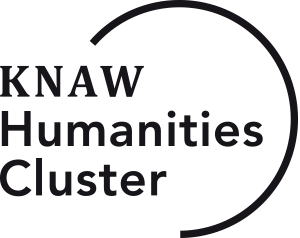
Does the Humanities Cluster need to build national infrastructure?
* Nederlands onder de Engelse tekst *
Interview with Menno Rasch
Menno Rasch has now been director of the KNAW Humanities Cluster’s Digital Infrastructure department for several months. He has made good use of that time to get to know the organisation and his group of developers. He is convinced that his IT staff can have a major impact on research. But then successful collaboration within HuC must take shape outside the KNAW as well. Together we can always achieve more.
This may not be the coursework that immediately springs to mind when you think of a director of a digital infrastructure department, but Menno Rasch studied both computer science and philosophy in Utrecht. Before he began work at the KNAW Humanities Cluster (HuC) he used to tell IT people that he studied computer science and then also philosophy. With humanities scholars he usually turned it around—that he’d studied philosophy but then also computer science. But he hasn’t quite figured out how to present himself inside the HuC where the digital humanities are so central.
But notwithstanding this devilish dilemma, Menno feels completely at home at the HuC. “This is a rare opportunity for me. I have an affinity with the humanities. And I also get to work with a group of IT developers who are unique in the Netherlands and perhaps further, on an infrastructure that tries to be as close as possible to what researchers require. The development of digital infrastructure and research tools makes better and innovative research possible, which you can then also carry out more quickly. Facilitating that and making sure it actually happens is what I like most about my new job.”
Difficult puzzle
Despite this Menno realizes that it’s a difficult puzzle to solve the very specific needs of a researcher in a generic manner as possible. However, he emphasizes that this is precisely what is needed to increase reusability and thus speed up the process. “If we are able to set up a generic foundation very quickly, we can use the remaining project time to develop the specific components.”
To accomplish this, many conversations with researchers are needed. And especially the right conversations between IT staff and researchers. Menno: “If they have the right conversation at the right moment, you’ll see great things happen. It can lead to ground-breaking research that was not even possible a few years ago. IT staff really can have a significant impact on research.”
It is also important that researchers are enabled and supported. This also means that the institutional management must be convinced of the added value of a DI department. Fortunately, this is already the case at HuC. It is no coincidence that IT has been brought together within HuC, and DI is seen as providing significant added value through its collaboration with the HuC.
HuC strategically smart
“I think the HuC is strategically very smart. The institutes don’t operate as separate islands but have bundled their resources. It’s more efficient and more effective if you get IT staff together and ensure that they start to use each other’s infrastructure and ultimately grow this into a larger, common infrastructure.”
In recent years, the focus was on creating a single DI department. That process has now been completed. Menno: “I see a department, a group. So now is the time to work towards an integrated infrastructure and to present the department more compellingly to the outside world as a reliable, expert partner that can take part in projects building infrastructure for the humanities. However, the HuC does not have the funding to build the infrastructure for the humanities in the Netherlands on its own. That would be over-ambitious, I think. You can ask yourself whether the three HuC institutes are set-up to create national infrastructure. It is already means quite a lot to put some of that money together to contribute towards a national infrastructure.”
And Menno points out that a new task will arise – building and maintaining digital collections. Managing them is usually more expensive than managing paper collections even while the lump sum available for these tasks remains the same. So how do you find the means to pay for all of this? But as far as Menno is concerned, that’s not a separate problem: “Actually, it’s all connected. When you talk about collections, you’re also talking about data. You can’t manage data without infrastructure. You have to store it somewhere and then you have to make it searchable and accessible. That is exactly what our infrastructure does.”
National infrastructure
According to Menno, the funding issue can only be solved nationally. And a national infrastructure is the task of CLARIAH. But he recognizes that organising this is still difficult at this moment. “There is no common target on the horizon. The partners are primarily concerned with their own priorities. The development of a national infrastructure requires very close cooperation where you have to leave the interests of your own organisation behind for a while to focus on the common interest. But in the end, that will result in something that is of great importance to your own group. That, I know for a fact.”
Courageous decision
There is thus a way forward, but Menno knows that it requires a courageous decision for an organisation to say: we really need to build the infrastructure for the humanities together, otherwise we won’t get there. The three KNAW institutes (Huygens ING, International Institute for Social History, and Meertens Institute) have taken resolute steps by setting up the HuC and bringing their IT staff together. In doing so, the HuC is demonstrating what a joining of forces can accomplish. That can also serve as an example for others. Of course, such a cooperation does not have to follow the same organizational structure as the HuC. It could, for example, also follow the structure of the Netwerk Digitaal Erfgoed (Network Digital Heritage). That is a partnership of heritage institutions working together on digital sustainability. There you can already see collaborations gradually taking shape. ’
I really believe in smart structural cooperation between all of these parties. That is the key to moving things forward. All the same, there is no guarantee that it will work. And that’s why I find it exciting to be involved in venture.”
Moet het HuC wel nationale infrastructuur bouwen?
Interview met Menno Rasch
Menno Rasch is ondertussen al een aantal maanden directeur bij het KNAW Humanities Cluster van de afdeling Digitale Infrastructuur. Die tijd heeft hij goed gebruikt om de organisatie en zijn groep ontwikkelaars te leren kennen. Hij is ervan overtuigd dat zijn IT’ers een grote impact kunnen hebben op het onderzoek. Maar dan moet de succesvolle samenwerking binnen het HuC ook buiten de KNAW gestalte krijgen. Samen kunnen we immers veel meer bereiken.
Het zijn wellicht niet de opleidingen waar je meteen aan denkt bij een directeur van de afdeling Digitale Infrastructuur, maar Menno Rasch studeerde in Utrecht zowel Informatica als Filosofie. Voor hij bij het KNAW Humanities Cluster (HuC) werkte, vertelde hij IT’ers altijd dat hij Informatica studeerde, en daarnaast filosofie. Bij geesteswetenschappers draaide hij het meestal om. Dan studeerde hij filosofie en had hij ook nog informatica gedaan. Maar hij is er nog niet helemaal over uit hoe hij zich moet voorstellen binnen het HuC, waar de digital humanities centraal staan.
Maar ondanks dat duivelse dilemma, zit Menno bij het HuC helemaal op z’n plek. ‘Dit is voor mij een buitenkans. Ik heb affiniteit met de humanities. En ik mag werken met een groep IT’ers die uniek is in Nederland en misschien daarbuiten ook wel, aan een infrastructuur die zo dicht mogelijk aansluit bij wat onderzoekers nodig hebben. De ontwikkeling van digitale infrastructuur en researchtools maakt nieuw en beter onderzoek mogelijk, dat je ook nog sneller kunt uitvoeren. Dat faciliteren en er ook voor zorgen dat het er ook echt komt, dat vind ik inhoudelijk het leukste aan mijn nieuwe baan.’
Grote puzzel
Maar Menno realiseert zich dat het een grote puzzel is om heel specifieke wensen van een onderzoeker zo generiek mogelijk op te lossen. Hij benadrukt echter dat juist dat nodig is om de herbruikbaarheid te vergroten en dan daarmee te versnellen. Wanneer we in staat zijn om met hulp van een generieke basis in korte tijd iets goed neer kunnen zetten, dan kunnen we de overgebleven projecttijd gebruiken om specifieke diensten te ontwikkelen.
Om dat te bereiken zijn veel gesprekken met onderzoekers nodig. En dan vooral het juiste gesprek tussen IT’ers en onderzoekers. Menno: ‘Wanneer zij op het juiste moment het juiste gesprek voeren, dan zie je mooie dingen ontstaan. Dat kan leiden tot baanbrekend onderzoek dat een aantal jaren geleden nog niet mogelijk was. IT’ers kunnen echt een grote impact hebben op het onderzoek.’
HuC strategisch heel slim
Daarnaast is het ook belangrijk dat onderzoekers worden ontzorgd en gefaciliteerd. Dat betekent ook dat het management overtuigd moet zijn van de toegevoegde waarde van DI. Gelukkig is dat bij het HuC het geval. Niet voor niets werd binnen het HuC IT bij elkaar gebracht, en wordt DI gezien als een belangrijke meerwaarde van de samenwerking in het HuC.
‘Ik vind het HuC strategisch heel slim. Dat de instituten niet als eilandjes opereren, maar de krachten bundelen. Het is efficiënter, en effectiever, wanneer je de IT’ers bij elkaar zet en zorgt dat men gebruik gaat maken van elkaars infrastructuur en uiteindelijk doorgroeit naar een gemeenschappelijke infrastructuur.’
De afgelopen jaren stonden in het teken van het vormen van één afdeling DI. Dat traject is nu afgerond. Menno: ‘Ik zie een afdeling, een groep. Nu is dus het moment om naar een geïntegreerde infrastructuur toe te werken en de afdeling naar buiten toe krachtiger neer te zetten als betrouwbare, deskundige partij die mee kan doen in projecten die infrastructuur voor geesteswetenschappen bouwt.
Landelijke infrastructuur
Het HuC heeft echter niet de financiering om de infrastructuur voor de humanities in Nederland in haar eentje te realiseren. Dat zou een heel overspannen ambitie zijn, denk ik. Je kan je afvragen of de drie instituten zijn opgericht om landelijke infrastructuur te bouwen. Het is al heel wat om een stukje van dat geld bij elkaar te leggen om zo een bijdrage te leveren aan een nationale infrastructuur.’
En Menno wijst er op dat daar dan nog een nieuwe taak bij komt: het opbouwen en beheren van digitale collecties. Het beheer daarvan is doorgaans duurder dan van papieren collecties, terwijl de lumpsum hetzelfde blijft. Dus waar betaal je dit allemaal dan van?
Maar wat Menno betreft is dat niet een apart probleem: ‘Eigenlijk loopt het allemaal in elkaar over. Als je het hebt over collecties dan heb je het over data. Heb je het over data dan heb je het eigenlijk over infrastructuur. Data zonder infrastructuur bestaat niet. Je moet het ergens in opslaan en daarna moet je het doorzoekbaar maken en je moet het toegankelijk maken. Dat is precies wat onze infrastructuur doet.’
Moeizaam
Volgens Menno kan het financieringsvraagstuk alleen nationaal worden opgelost. En een nationale infrastructuur is de taak van CLARIAH. Maar hij stelt vast dat het organiseren daarvan op dit moment nog moeizaam gaat. ‘Er ontbreekt een gemeenschappelijke stip op de horizon. Partners zijn allereerst met hun eigen stukje bezig. Terwijl het ontwikkelen van nationale infrastructuur hele nauwe samenwerking vergt, waarin je het belang van je eigen organisatie even achter je moet laten omdat je je moet focussen op het gemeenschappelijke belang. Maar dat levert uiteindelijk wel iets op dat van groot belang is voor je eigen club. Dat weet ik zeker.’
Moedige besluiten
Er is een oplossing, maar Menno weet dat het moedige besluiten vergt van organisaties om te zeggen: die infrastructuur voor de humanities moeten we echt gezamenlijk gaan bouwen, anders komen we er niet. ‘De drie KNAW instituten hebben die moedige stappen gezet met het oprichten van het HuC en het samenbrengen van de IT’ers. Daarmee laat het HuC zien wat een krachtenbundeling oplevert. Dat kan als voorbeeld dienen. Die samenwerking hoeft natuurlijk niet langs dezelfde organisatiestructuur als het HuC. Het kan ook zoals bij het NDE. Dat is een samenwerkingsverband van erfgoedinstellingen op het thema digitale duurzaamheid. Daar zie je die samenwerking al langzamerhand ontstaan.’
‘Ik geloof echt in slimme structurele samenwerking tussen al deze partijen. Dat is de sleutel om verder te komen. Er is echter geen garantie dat het gaat lukken. Daarom vind ik het spannend om hier mee bezig te zijn.’








